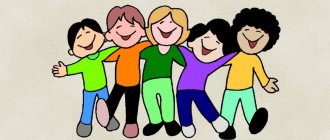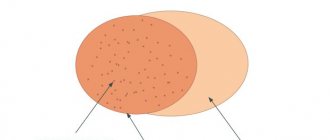How women attract attention and how men attract attention. What are the differences?
Men and women are not always in a hurry to admit their feelings. But in the presence of the object of their sympathy, some of their gestures cannot remain silent about sympathy. Subconsciously they attract attention to themselves. And sometimes only a very observant person will be able to read the meaning of these gestures.
The difference between female and male gestures is that a woman shows her weakness and femininity, and a man tries to demonstrate his strength.
What do men do:
- They begin to straighten their clothes, hairstyle, and brush off non-existent specks of dust.
- In the presence of a woman he likes, a man immediately looks younger: he straightens his shoulders, sucks in his stomach, his eyes sparkle brighter than before.
- A man can keep his hands in his pockets with the thumb facing out or put his fingers behind his belt
- A man can hold his head up, thereby demonstrating himself in all his glory
- Looks at the woman with a long, searching gaze
What do women do:
- A woman shakes her hair, straightens her hair, sometimes begins to twirl her curls on her finger, the latter is not always a sign of sympathy (some people just like to do this)
- While walking under the gaze of the object of sympathy, a woman begins to sway her hips more than usual
- A woman attracts attention with short glances from under her eyelashes and shoots with her eyes. As soon as a man catches her gaze, she immediately averts her eyes with her hands; a woman can casually stroke her thighs or touch her chest, showing off her tender wrist
- Strokes the stem of a glass, pencil, or other cone-shaped object
- A muffled voice, wet, parted lips and a languid gaze are a frank call for love.
- A woman attracts attention by crossing her legs. Sometimes she does it too openly
Body language: human nonverbal gestures
Psychologists often pay attention to famous politicians and stars during their speeches. While a person's eyes are difficult to see from a distance, and most of the speaker's body is usually hidden by the podium or the camera filming them, the hands remain the only means of non-verbal language. And they can tell a lot of interesting details. Features of gestures:
- open palms - a person is sincere and frank;
- clenched fists - an expression of disagreement with the topic of conversation and aggression
- stroking the chin - a person is thinking or preparing to make a decision
- fussy movement of the hands (expressed in stroking, rubbing, fiddling with some object) - expresses nervousness and embarrassment
- scratching the back of the head and rubbing the forehead, ear or cheeks means embarrassment, self-doubt, concern about the topic of the conversation;
- tilting the head to the side - interest in the topic of conversation
- playing with the hair on the head (twisting strands around a finger, removing hair from the forehead, etc.) - expresses a feeling of discomfort from the conversation and anxiety;
Read more: Apperception
active gestures mean that a person is inspired, positive and communicative.
Gestures in non-verbal communication can also be open and closed: Open - indicate the interlocutor’s sincere interest and trust. They manifest themselves in active gestures, an attempt to come closer to the interlocutor, unbuttoning a button on a jacket and placing the palms up. Closed ones indicate a reluctance to communicate and dislike for the interlocutor. Manifested in crossing the arms in the chest area and crossing the legs.
When paying attention to the behavior of your interlocutor, it is also worth remembering the difference between male and female gestures. For example, women are more likely to gesture during a conversation if the topic attracts them and is pleasant to them. Next to an unpleasant person, ladies, on the contrary, tend to seem to become smaller and step aside. A woman’s interest can be determined by open gestures and an attempt to come closer to the interlocutor. As for men, they tend to express irritation through active gestures, and their mood is easier to understand by the position in which they are. For example, a relaxed posture means openness, trust in the interlocutor and readiness to carry on a conversation. If a man hunches over, puts his shoulders together and puts his hands in front of him, then he is thus trying to isolate himself from an uninteresting and unpleasant interlocutor.
Nonverbal expressions of sexual interest
Women show interest in men by folding their legs crosswise, playing with half-off shoes, and also straightening their hair. Also, when they like a man, ladies begin to “fidget” in their chair more often. Men express sympathy most often through eye contact. They very often look at the object of passion. In addition, when a woman is desired, men also tend to adjust their hair, the belt on their trousers, and check their breath for freshness. If a pretty woman is sitting opposite you, the man will definitely point his feet towards her.
Why is it worth watching a girl?
Before concluding that this girl is too clumsy or too provocative, a guy should watch her for a while. Perhaps she is just trying to attract him to her in this way.
Important: Often, when we fall in love, we behave differently than usual. We try to appear better than we really are or, conversely, we want to create an unapproachable image.
Features of foreign language of facial expressions and gestures
Abroad, the language of facial expressions and gestures, understandable to the residents of Russia, is transformed and modified. When planning a trip to a particular country, you must definitely study the meaning of non-verbal signals in this country, since the same gestures in different countries can be interpreted differently.
For example, hugging and kissing when meeting in England is regarded as vulgar behavior. By tapping his finger on his nose, the Englishman emphasizes that his words are secret information. A clenched fist with the index finger raised is considered an offensive gesture in England.
If in Holland a person twirls his finger at his temple during a conversation, he emphasizes the wit of his interlocutor. Rubbing the back of his nose, the Dutchman talks about greed.
The French express their admiration for something by blowing a kiss. If a Frenchman pulls his lower eyelid down with his index finger, he expresses doubt in the words of his interlocutor. In France, distrust of a person is expressed by rubbing the bridge of the nose.
Thus, in the psychology of communication, human facial expressions and gestures play an important role. They make communication interesting and help distinguish truth from lies. Knowledge of the facial expressions and gestures of other countries will help you avoid awkward situations when communicating with foreigners.
Communication with foreigners
Eye contact: short or long gaze
- Looking for a long time (more than 1-2 seconds) towards a stranger is considered indecent. A person may perceive it as a gesture of aggression. The exception is lovers
- A man can watch a woman he likes for a long time and intently, often lingering on his chest, hips, and neck. Sometimes these views can be completely unceremonious
It’s not for nothing that they say that a man loves with his eyes.
- Short glances can also be signs of love, but this is how shy people look. Usually women use short glances as a game. They languidly spy on the man, doing everything so that he catches their gaze. But as soon as the man noticed, the woman slyly averts her eyes to the side
- To establish trust, look at the person and smile at him. If people who like each other are united by a common situation, you can use a long look. For example, you wanted to take one glass at the same time and looked at each other for a long time. This suggests that your attempt to attract attention was seen and understood
Gestures and emotions
There are several levels of gestures depending on the emotional state of a person.
Our basic gestures usually do not fall below waist level and do not rise above shoulder level. This range corresponds to a stably equal emotional state. This is a sign that we are calm and comfortable.
What happens to a person when he is upset, dejected, or oppressed by problems? As they say, “he gives up and doesn’t want anything.” In this state, gestures become spare, not sweeping, and are distributed at the lower level.
Anger, or irrepressible joy, passionate desire, the desire to lead, to command - all these are points of the highest intensity of passions. This state is characterized by upper-level gestures (from the shoulders and above). Remember the fiery speeches of political leaders, dictators, and religious fanatics. The speeches of these speakers strive to awaken the desired emotions in the listeners, and the periodic use of overhead gestures is of great benefit to them. The higher the hands, the brighter the emotion.
Our brain is directly connected to our body; they are inseparable and dependent on each other. Therefore, everything that we think, plan or dream about manifests itself in the form of internal or external reactions of the body (we threaten - we wave, we approve - we nod, we get angry - we attack). And in reverse order, any impact on our body from the outside immediately finds a response in our brain (any touch - activation of attention, burn - jerking, hitting the table with your fist - confirm your decision, acceleration of movement - mobilization of the physical forces of the body, etc. .).
It turns out that these properties of connections and dependencies can be easily used with incredible benefit for your loved one.
For example, a person came home nervous. They were rude in the store, got caught in the rain without an umbrella, etc. My heart is pounding, my adrenaline is overflowing - if only I could catch up with someone and bite me, I would immediately feel better! And then your beloved cat comes up. The owner begins to stroke her, but not at the speed of his angry heart, but slowly and affectionately. The rhythm from the hand is gradually transmitted to the brain and the person calms down. A few more minutes and you can take an objective look at the current situation.
Location: always next to the guy
A clear sign of female sympathy is the desire to follow a man.
Guys, don’t be surprised if you “accidentally” meet a girl you don’t know all the time. This may not be a random meeting at all.
- If you like a guy, but the girl doesn’t know him yet, she will start looking for ways to intersect them. A girl who is constantly next to a guy clearly sympathizes with him
- If the girl is your old friend, pay attention to how quickly she agrees to change her location with you. For example, when visiting friends, invite her to sit in the kitchen, at a disco, invite her to another table, even if she just interrupts her conversation with her friend for you - this may indicate feelings for you
The girl wants to please: perfect makeup and hairstyle
A woman's appearance has a powerful effect on the stronger sex, and women know this. Therefore, a woman tries to please her beloved man by carefully choosing her hairstyle and makeup.
Important: Girls, do not overdo it with makeup, sometimes the result can be disastrous.
The fact is that a woman’s and a man’s concept of beauty can be very different. Women who are too sleek, expensively dressed and ideal in appearance seem inaccessible and cold to men. Although men really value grooming, naturalness and neatness in women.
Smile is different from smile: how not to make a mistake?
One of the most powerful means of seduction is a smile. However, not every smile can be perceived as a gesture of goodwill and goodwill. You can attract a man only with a sincere smile.
You can always feel a forced smile when you are not in a good mood at all. Also, a forced smile can not only bring a man closer, but also push him away. For example, he may think that you are smiling at him only because the rules of decency require it and nothing more.
Important: Do not try to seduce a man with an insincere smile.
How to learn sign language
In this article we will look at teaching Russian Sign Language (RSL). Because this is what they use in Russia, and you will have to deal with it in everyday life.
RSL differs from other sign languages in vocabulary and grammar. At the same time, it differs from the grammar of the Russian spoken language in the complex morphological transformation of words.
The vocabulary of RSL is close to international, because many gestures were taken from German, Austrian and French sign languages.
Introduction to dactylology
You need to start learning sign language by getting acquainted with dactylology. This is a special form of speech in which each letter of the alphabet is indicated by a certain sign made of fingers.
The dactyl alphabet has 33 signs (dactyls), just like the alphabet.
These letter designations are only a small part of sign language. Dactylology is usually used to convey proper names: cities, names, localities and other words that do not have a special gesture.
Basically, deaf and dumb people use gestures to indicate words or entire phrases.
In addition, there is manoral speech - lip reading. Gestures in this case only emphasize certain letters and syllables (hard, soft, voiceless, voiced consonants).
Finger placement technique
In communication in Russian Language, every movement and position of the hands plays a role. So you need to learn sign language slowly, thoroughly working out the technique of placing your fingers.
At the beginning of training, the hand and fingers can quickly get tired. Take breaks. After a few workouts, you will begin to get used to the movements, your arms will adapt, and you will become more resilient.
You can do gymnastics for your hands and fingers to make them bend better.
Fingering speed
Once you have perfected the technique and precision of your finger placement, you can increase your speed. Choose the word you want to learn to pronounce in dactyl. For example, your own name.
Memorize all the signs that need to be shown, stand in front of the mirror and practice. First, just repeat the movements to remember, and then try to show them faster.
Try not to compromise precision of movements for the sake of speed.
Counting and numbers
Once you've honed your knowledge of the alphabet, it's time to move on - time to learn how to show numbers.
To get started, counting from 1 to 10 is enough.
Later, you can expand your knowledge by expanding your knowledge to hundreds.
The meaning of gestures and postures: which poses attract attention and which ones repel?
If you don’t want to push a man away from you, don’t take closed poses :
- Crossed arms and legs indicate that you do not want to continue dating
- Crossed arms but no legs - a sign of doubt, you don’t know whether to continue communication
- Palms outstretched forward - the signal “That’s it, that’s enough!” I'm tired"
- Don't act like you're bored
- Avoid aggressive gestures: do not roll your eyes under your forehead, do not look down at your partner
- The hands that you hold behind your back are subconsciously perceived by a man as a stone in his bosom
Adopt friendly and open postures:
- Arms and legs should not be crossed when communicating
- Look the other person in the eye during a conversation
- During communication, your body should be turned towards the man
Nonverbal communication: facial expressions, gestures, movements, postures and their meaning
Sign language is one of the forms of self-expression, without the use of words and speech symbols. This language was discussed in detail by the Austrian writer Alan Pease, in his work entitled “Body Language”. According to the writer, only seven percent of all information received is perceived by a person using words. The remaining ninety-three percent is perceived by a person thanks to non-verbal signals. Let's look at what nonverbal communication, facial expressions, gestures, movements, postures are and their meaning.
Our body language, compared to other verbal (speech) means of communication, is unique
How to recognize female sympathy: tips and reviews
Roman, 26 years old : “Girls are treacherous creatures. I am always wary of a girl's overly frank behavior. This is a clear sign that you need something from her.”
Inna, 30 years old : “There can be no universal advice. Some girls are modest and silent. And others know how to take the initiative into their own hands. We need to look at each case individually.”
Alexey, 41 years old : “I’m not a teenager anymore. Just from one conversation with a woman I can understand whether she likes me or not.”
Maxim, 19 years old : “Watch the girl. Her behavior will reveal her attitude towards you. If she behaves differently with you than with everyone else, then something is no longer right.”
Body language is very eloquent. Watch the people you like more closely. Maybe they have been secretly sighing for you for a long time, but they are afraid to say so.
What is sign language
Russian Sign Language (RSL) is an independent language that is used for communication by people with hearing loss.
It consists not only of static figures, but also of a dynamic component. The hands move in a certain way, occupy a certain place in relation to the face. During gestures, it is customary to additionally “pronounce” words with your lips.
In FL, any details are important, including where the gesture is shown (at the forehead and chest, the same movements are interpreted differently), the nature of the movements (rotation of the body and head, facial expressions). We can say that the whole body is involved in the conversation.
When communicating in sign language, every little thing plays a role, so you need to watch your posture and involuntary hand movements. All your actions can be misinterpreted.









